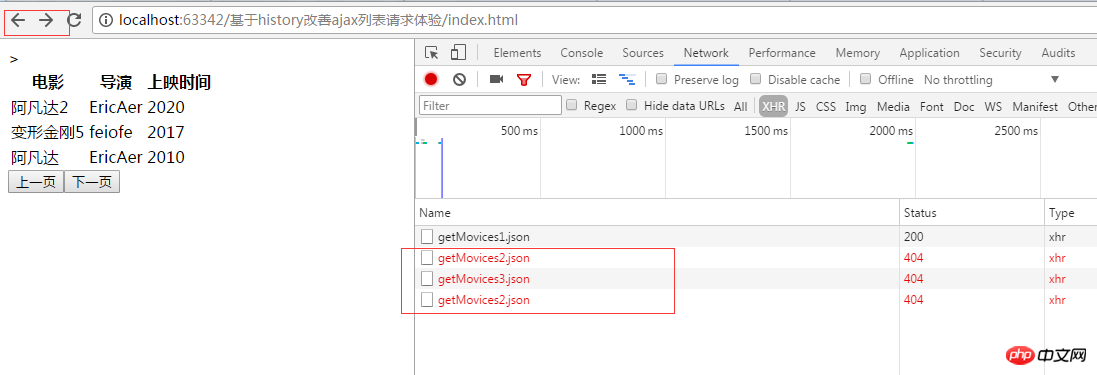Home >Web Front-end >JS Tutorial >Solve the problem of ajax not supporting forward/back/refresh through history (graphic tutorial)
Solve the problem of ajax not supporting forward/back/refresh through history (graphic tutorial)
- 亚连Original
- 2018-05-22 10:42:451588browse
Below I will bring you an article to solve the problem of ajax not supporting forward/back/refresh through history. Let me share it with you now and give it as a reference for everyone.
Foreword:
Nowadays, the front-end and back-end basically realize the interaction of front-end and back-end interface data through ajax. However, ajax has a small Disadvantages: Does not support browser "back" and "forward" keys.
However, now we can solve this small bug in ajax interactive requests through the history attribute of H5.
Event description:
H5 adds an event window.onpopstate. This event will be triggered when the user clicks those two buttons. But it is not enough to detect this event. You must also be able to pass some parameters. That is to say, when returning to the previous page, you must know the pageIndex of that page. This can be done through the pushState method of history. pushState(pageIndex) stores the pageIndex of the current page, and then obtains the pageIndex when returning to this page.
window.history.pushState Description:
window.history.pushState(state, title, url);
state object: is a JavaScript object that is related to The new history entity created by the pushState() method. Used to store information about the entry you want to insert into the history. State object can be any Json string. Because Firefox will use the user's hard disk to access the state object, the maximum storage space of this object is 640k. If it is greater than this value, the pushState() method will throw an exception.
title: firefox now ignores this parameter, although it may be used in the future. The safest way to use it now is to pass an empty string to prevent future modifications.
url: Used to pass the URL of the new history entity. The browser will not load this URL after calling the pushState() method. Maybe try loading this URL after a while. For example, after the user restarts the browser, the new URL may not be an absolute path. If it is a relative path, it will be relative to the existing url. The new url must be in the same domain as the existing url, otherwise pushState() will throw an exception. This parameter is optional. If it is empty, it will be set to the current URL of the document.
Post the code directly:
/**
* Created: Aaron.
* address: http://www.cnblogs.com/aaron-pan/
*/
//var pageIndex=window.history.state===null?0:window.history.state.page;
(function($,window,undefined){
var loadData={
pageIndex:window.history.state===null?1:window.history.state.page,
//pageIndex:0,
init:function(){
this.getData(this.pageIndex);
this.nextPage();
},
getData:function(pageIndex){
var that=this;
$.ajax({
type:'post',
url:'./data/getMovices'+pageIndex+'.json',
dataType:'json',
async:false,
success:function(data){
that.renderDom(data);
}
})
},
renderDom:function(movies){
var bookHtml=
"<table>"+
"<tr>"+
"<th>电影</th>>"+
"<th>导演</th>"+
"<th>上映时间</th>"+
"</tr>";
for(var i=0;i<movies.length;i++){
bookHtml +=
"<tr>" +
" <td>" + movies[i].moviesName + "</td>" +
" <td><a>" + movies[i].moviesEditor + "</a></td>" +
" <td>" + movies[i].times + "</td>" +
"</tr>";
}
bookHtml+="</table>";
bookHtml +=
"<button>上一页</button>" +
"<button class='nextPage'>下一页</button>";
$('body').html(bookHtml);
},
nextPage:function(){
var that=this;
$(document).on("click",".nextPage",function(){
that.pageIndex++;
that.getData(that.pageIndex);
window.history.pushState({page:that.pageIndex},null,window.location.href);
//后退and刷新回到首页 window.history.replaceState({page:that.pageIndex},null,window.location.href);
})
},
};
loadData.init();
window.addEventListener("popstate",function(event){
var page=0;
if(event.state!==null){
page=event.state.page;
console.log('page:'+page);
}
console.log('page:'+page);
loadData.getData(page);
loadData.pageIndex=page;
})
})(jQuery,window,undefined);You can see the running results by calling the js file directly on the html page.
Running result:

#In this way, you can interact through ajax and also realize the function of monitoring forward/background/refresh .
Attached browser compatibility:

The above is what I compiled for everyone. I hope it will be helpful to everyone in the future.
Related articles:
jquery ajaxHow to implement paging function
##jQuery AJAX timeout timeout emergency processing method
Use JQuery to operate Ajax (with case)
The above is the detailed content of Solve the problem of ajax not supporting forward/back/refresh through history (graphic tutorial). For more information, please follow other related articles on the PHP Chinese website!
Related articles
See more- An in-depth analysis of the Bootstrap list group component
- Detailed explanation of JavaScript function currying
- Complete example of JS password generation and strength detection (with demo source code download)
- Angularjs integrates WeChat UI (weui)
- How to quickly switch between Traditional Chinese and Simplified Chinese with JavaScript and the trick for websites to support switching between Simplified and Traditional Chinese_javascript skills

